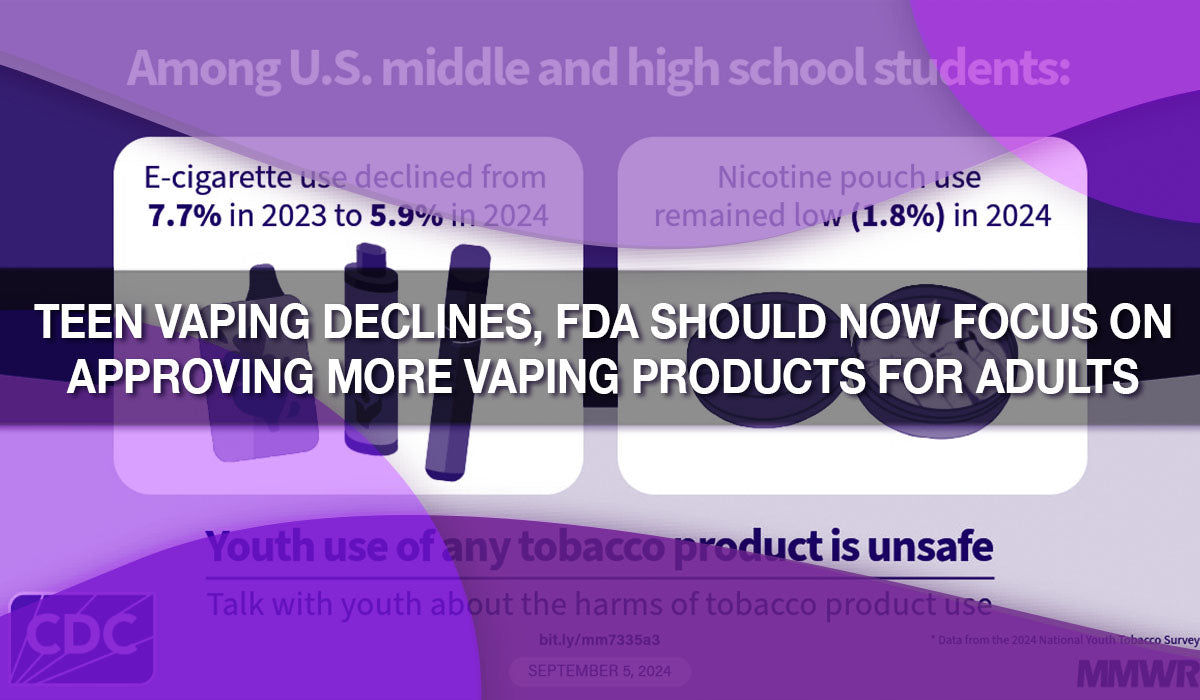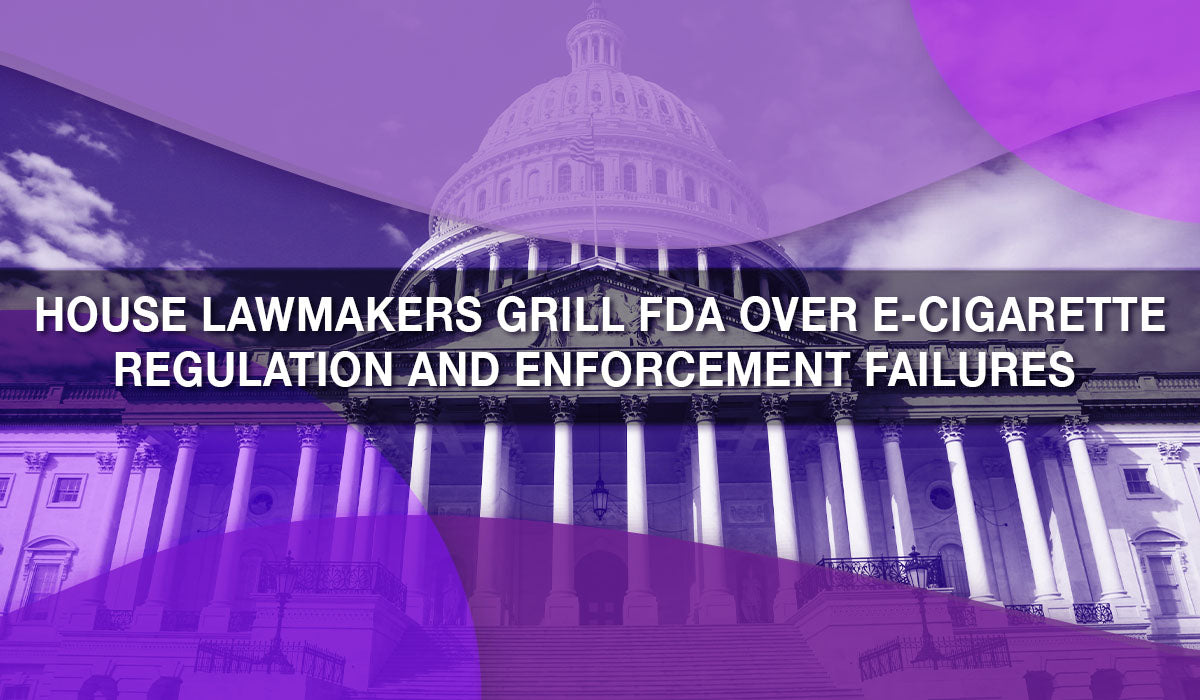
Teen Vaping Declines, FDA Should Now Focus on Approving More Vaping Products for Adults
The latest report from the Centers for Disease Control and Prevention (CDC) brings encouraging news: e-cigarette usage among teens has reached a 10-year low. According to the data, only 5.9% of students in grades 6-12 reported vaping in the past 30 days—a significant drop from 7.7% just a year ago, and far from the peak levels in 2019, when teen vaping rates were three times higher.

While this decline reflects the success of public health campaigns and tighter regulations aimed at reducing youth vaping, it also opens the door for the FDA to shift its focus. With teen usage falling, it's time for the agency to accelerate the approval of vaping products intended for adult smokers who are trying to quit.
To secure these public health gains, we need to achieve sustained reductions in youth tobacco use while preserving non-combustible alternatives like pouches and e-cigs for currently addicted adult smokers who want to use these products to fully transition off cigarettes.
— Scott Gottlieb, MD (@ScottGottliebMD) September 5, 2024
The FDA's Role
The FDA’s regulatory framework for e-cigarettes has largely been shaped by concerns over youth vaping. However, now that the data shows a steady decline in teen usage, there is a strong argument for the FDA to focus on the potential value that vaping products provide to adult smokers.
Millions of adult smokers have turned to vaping as an alternative to combustible cigarettes. Numerous studies, like the Cochrane review support the fact that e-cigarettes and vaping products are effective tools for smoking cessation, as they deliver nicotine without the tar and other toxic chemicals found in traditional cigarettes.
“Electronic cigarettes have generated a lot of misunderstanding in both the public health community and the popular press since their introduction over a decade ago. These misunderstandings discourage some people from using e-cigarettes as a stop smoking tool. Fortunately, more and more evidence is emerging and provides further clarity. With support from Cancer Research UK, we search for new evidence every month as part of a living systematic review. We identify and combine the strongest evidence from the most reliable scientific studies currently available.
For the first time, this has given us high-certainty evidence that e-cigarettes are even more effective at helping people to quit smoking than traditional nicotine replacement therapies, like patches or gums.” Dr Jamie Hartmann-Boyce, Associate Professor at the University of Oxford, Editor of the Cochrane Tobacco Addiction Group
Public Health England, for example, has consistently found that vaping is about 95% less harmful than smoking and remains a key element in the UK’s anti-smoking strategy.

Despite this, the FDA has been slow to approve vaping products under its Premarket Tobacco Product Application (PMTA) process.
In the meantime, adult smokers are left with limited access to regulated, affordable and high-quality vaping products. The FDA has only approved a limited number of vaping devices, most manufactured by the tobacco industry and all substantially more expensive to operate than refillable (open) systems and disposable vapes.

A Time for Balance: Protecting Youth While Supporting Adults
The decline in teen vaping rates shows that some of FDA’s efforts to curb youth e-cigarette use are working. Enforcing stricter age verification measures, has succeeded in driving down underage use while outright bans and false messaging have restricted adult access to the products the prefer to use, in some instances pushing adults back to smoking.
As teen usage drops, the FDA should reconsider its approach to vaping products that are specifically designed for adult smokers. Products with proven track records in helping people quit smoking should be prioritized for approval, ensuring that adults can make safer choices without inadvertently pushing them back toward combustible cigarettes.
Why Approval of More Vaping Products Matters
For many adult smokers, vaping is not just an alternative to cigarettes—it’s a way to put combustibles in the rearview mirror. Numerous anecdotal stories, as well as scientific studies, highlight the success of vaping in reducing cigarette consumption. The availability of diverse vaping products, especially those with varying nicotine strengths and flavors, is crucial to supporting smokers on their journey.
However, the current lack of FDA-approved products means that many people who smoke are left with fewer choices. In some cases, people who smoke are unable to find the right vape product. As the studies in areas with flavor bans have shown, many revert to smoking traditional cigarettes, which remain the leading cause of preventable death in the U.S.
The FDA has the authority to prevent this backslide by approving more vaping products aimed at adults. These products should meet the highest safety standards, but they should also be accessible, available, and diverse in flavor and nicotine options to cater to the different needs of each person.
The Need for Flavored Vaping Products for Adults
One key aspect of this conversation is the role of flavored vaping products. While flavored e-cigarettes have been criticized for their appeal to teens, they are also crucial for adult smokers who rely on them to quit. Studies have shown that adults who use flavored e-cigarettes are more likely to successfully quit smoking than those who use tobacco-flavored or unflavored alternatives.
A vaping study with a sample of nearly 70,000 adult vapers in the U.S. found that the most utilized flavors to quit smoking in the U.S. are those of fruit, baked goods and chocolate.

The FDA should consider allowing the sale of flavored vaping products that are marketed and regulated specifically for adults. Stronger enforcement mechanisms—like enhanced age verification systems—could ensure these products don’t end up in the hands of minors while still providing adult that smoke with the variety they need.
Moving Forward: An Opportunity for Change
Smoking is still responsible for over 480,000 deaths annually in the U.S., and vaping remains one of the most promising alternatives. Now that youth vaping is declining, it’s time for the FDA to focus on approving more safe, effective, and regulated vaping products for adults.
The path forward should be one that balances the protection of youth with the support of adults that smoke.









Leave a comment
This site is protected by hCaptcha and the hCaptcha Privacy Policy and Terms of Service apply.